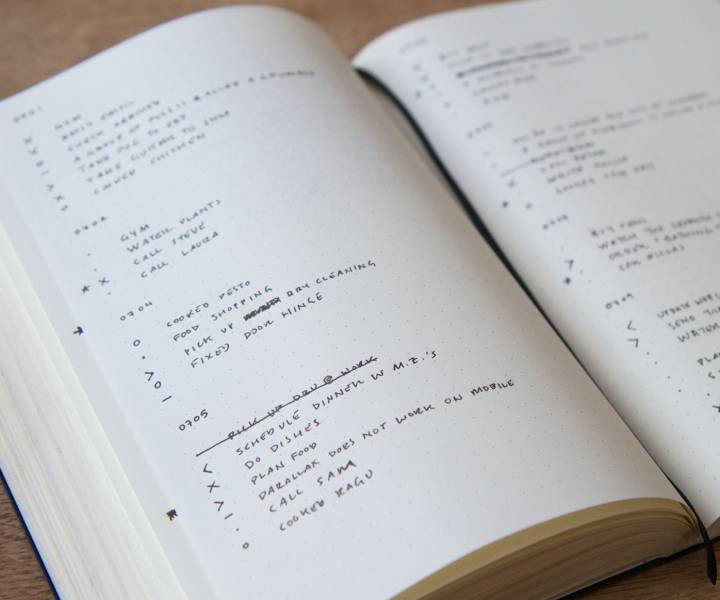Homes
How my bullet journal saved my life
by Sarah Maber

It’s time to ditch the diary and the tatty to-do list, bullet-journals are here and with them the power to turn the most disorganised person into a lean, mean very together machine.
Do you #BuJo? No, neither did I until I turned up for a coffee with my best friend a couple of months ago. Normally, we bond over our chaotic, time poor lives; with six children, two commuter husbands, three jobs, ailing parents and a vast array of pets between us, we both rely heavily on a patchy system of to do lists to help us manage the daily grind. Today, though, was different. ‘Have you heard about bullet journaling?’ she asked excitedly, while I scrabbled through my bag searching for the name of a dog walker I’d jotted down for her. ‘It’s a new thing – it’s all over the internet! I’ve tried it and it’s AMAZING. Everything goes in here,” she raved, patting a sleek black book, “and I never have that nagging feeling I’ve forgotten something anymore. Plus, I can always find phone numbers,’ she said pointedly, ‘because everything is in one place.’
Blimey. And this from a woman who’s previous filing system was the back of a nearest till receipt. On closer inspection, her ‘BuJo’ did seem to be impressively organised. She proudly showed me her index, pages of dated, neat to do lists, and sections for projects called things like ‘House Renovation!’ ‘Books for Tom!’ ‘Swimming teachers!’ ‘You see, it’s all here!’ she said. ‘You should try it, honestly. I feel like one of those scary organised people who are good at Getting Stuff Done.’ What a turnaround. And it had to be an improvement on my usual mash-up of post-its, lists, emails and digital reminders, didn’t it?
Turns out that she’s not alone in her love of the BuJo. Look up #bulletjournal on the social media platform of your choice, and you’ll pull up endless images of neatly inked notebook pages that track daily to dos, personal goals, projects, and even (permission given to roll your eyes) favourite inspirational quotes. If it all sounds a bit earnest and American, that’s because it is. Bullet journaling was dreamt up by Brooklyn-based digital designer Ryder Carroll and has taken the US by storm.
Back in Blighty, bullet journaling is still in its infancy. But the concept has received rave reviews by experts who say that minus the hype, BuJos are a great productivity tool that corral all your ideas, plans and to do lists into one master plan and help organise the chaos of daily life as well as reducing stress. “It’s a brilliant concept,” says British life coach and Life Clubs founder Nina Grunfeld. “Clearing your head with something like a bullet journal helps you focus and stay calmer. It makes you feel lighter.’ Research shows there could be other plus points too - a 2014 study published in the journal Psychological Science suggests that taking notes by hand – as opposed to typing on a laptop – boosts memory and allows you to better organise your thoughts. The system has won praise from top US neuroscientist Daniel Levitin, who praises it for its ability to ‘externalise your memory. A system like the bullet journal gets what’s in your head out there in the world.’

So how do you do it? Once you’ve got used to the jargon (see below), and watched Ryder Carroll’s original how-to video at bulletjournal.com a couple of times (number of views to date – a whopping four million), setting up your bullet journal is actually fairly straightforward. Simply find a blank notebook (any type or brand will do – I choose an unlined, leather bound notebook) and a pen, leave four blank pages for your index, then divide two pages into six sections. This will be your ‘future log’, where you jot down key tasks over the coming months (book holiday, for instance, or organize annual review). Next set up your ‘monthly log’ for that month’s to dos, and then a daily log where you can drill into your daily tasks. Number your pages and add all of these to you index… and you’re ready to go. Tasks are added in note form (a process Carroll terms ‘rapid logging’), and different sorts of to-dos are annotated by different symbols. A dot indicates a task, a circle an event, and arrows indicate if you’ve moved or rescheduled a task; a cross shows you when you’ve got it done.
The journal works on the principle that nothing need be lost if you write it down. Have a sudden thought about a book you’d like to read, or a present you want to get your other half? Write it down, with a dash in front of it, then add it to your index. If it’s a particularly brilliant thought, stick a ! in front of it. You can corral these thoughts into a collection (ideas for anniversary, for instance), then simply add this collection to your index with all the relevant page numbers written next to it. The beauty of your own bullet journal is that it becomes what you make it; mine is very functional; others use their journals like scrapbooks and mood boards.
Two months on and I am in still inawe of my BuJo’s ability to organize my life. I love the fact that all information and lists are now in one place, and better still, it’s sorted my priorities. By the time I’d copied over ‘’book tap lessons for Martha’ five times, I realized that perhaps it didn’t matter that much whether she had tap lessons or not. Ditto ‘Text Sue’, and ‘Send thank you note to in laws.’ What’s worked for me is keeping it ultra-simple. I don’t have much spare time, so the fact that it can be done and dusted in 10 minutes a day is crucial. So far, I have successfully resisted the temptation to add inspirational quotes, US style, and friends and family have all admired my little black book and newfound efficiency. Task achieved.
How to speak #BuJu:
Rapid logging: the ‘language’ of the bullet journal – short sentences and bullet points
Tasks: actionable items – pick up dry cleaning, or give cat flea treatment, for instance. Represented by a dot.
Events: date related entries – Charlie’s birthday; Elsie’s graduation. Represented by a circle.
Notes: facts, thoughts or ideas, indicated by a dash.
Index: the core of your journal, containing page numbers for all entries Future log: for tasks that need to be done in the future, or things you want to get around to one day.
Monthly log: a monthly calendar and task list.
Daily log: that day’s tasks, events and notes.
Migration: moving unresolved tasks into the next day or month. Indicated by > .
Collections: entries about one topic; ‘books to read’, ‘Birthday parties’, for instance.
But if you prefer to go digital…
Three of the best to-do list apps:
Wunderlist - easy peasy app for making lists and setting reminders, Microsoft liked it so much they bought the company.
Todoist - Neatly designed for manageable list-making. You can even set yourself deadlines to get things done.
Remember the milk - Syncs across devices, allows easy task and list creation, and sets deadlines and priorities.












